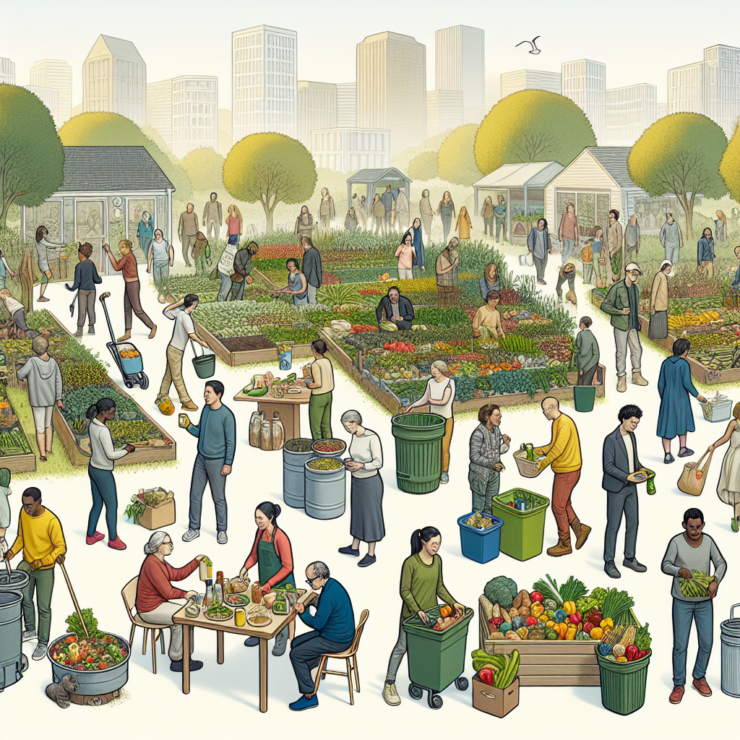Introduction to Sustainable Eating
In the midst of growing environmental concerns, the concept of sustainable eating has emerged as a crucial practice in the fight against climate change and ecological degradation. This section delves into what constitutes a sustainable diet and explores the significance of adopting such dietary habits.
Defining a Sustainable Diet
A sustainable diet is characterized by food choices that are not only beneficial for individual health but also for the environment. It emphasizes the consumption of foods that have a low environmental impact, supports ecosystems, and is accessible, economically fair, and culturally acceptable.
Sustainable diets generally share the following attributes:
- Low in meat and dairy consumption
- High in plant-based foods like vegetables, fruits, grains, and legumes
- Minimal use of highly processed foods that require more resources and energy to produce
- Preference for locally sourced and seasonally available foods to reduce transportation emissions
- Conservation of biodiversity by including a variety of foods in the diet
Why Sustainable Eating Matters
The food system significantly impacts the planet. It is estimated that it contributes to approximately one-quarter of global greenhouse gas emissions. Sustainable eating, therefore, becomes a tool for individuals to mitigate their ecological footprint. It allows for the preservation of resources and the protection of biodiversity, all while promoting personal health.
The importance of sustainable eating lies in its potential to address multiple challenges:
-
Climate Change: By reducing the consumption of high-emission foods like red meat, individuals can directly lower their carbon footprint.
-
Water Scarcity: Opting for foods with a lower water footprint contributes to the conservation of this vital resource.
-
Soil Health: Sustainable farming practices improve soil fertility, reducing the need for chemical fertilizers that can be harmful to the environment.
-
Ethical Considerations: Sustainable eating often involves consideration for animal welfare and labor practices within the food industry.
Embracing a sustainable diet is not only about what one eats but also how one sources and consumes food. It is a comprehensive approach that can lead to significant positive impacts on the environment and on personal well-being.
The Impact of Food Choices on the Environment
The choices one makes at the dinner table resonate far beyond personal health, influencing the health of the planet itself. Understanding the environmental impact of various foods can guide individuals on how to eat sustainably.
Carbon Footprint of Common Foods
The carbon footprint of food is a measure of the greenhouse gas emissions associated with its production, processing, distribution, consumption, and waste. Foods with higher carbon footprints contribute more to climate change. Meat products, particularly beef and lamb, have some of the highest carbon footprints.
| Food Type | Carbon Footprint (kg CO2e/kg product) |
|---|---|
| Beef | 27.0 – 40.0 |
| Lamb | 20.0 – 25.0 |
| Cheese | 8.5 – 13.5 |
| Pork | 5.0 – 7.0 |
| Chicken | 4.0 – 6.5 |
| Eggs | 3.0 – 4.5 |
| Rice | 2.5 – 3.5 |
| Potatoes | 0.3 – 0.4 |
Choosing foods with lower carbon footprints, such as plant-based proteins, can significantly reduce the environmental impact of one’s diet.
Water Usage in Food Production
Water usage is another critical factor in the sustainability of foods. It takes substantial amounts of water to produce food, but the exact amount varies widely depending on the product.
| Food Type | Water Usage (liters/kg product) |
|---|---|
| Beef | 15,000 – 20,000 |
| Chocolate | 17,000 – 24,000 |
| Nuts | 9,000 – 10,000 |
| Cheese | 3,000 – 5,000 |
| Rice | 2,500 – 3,000 |
| Eggs | 1,800 – 2,000 |
| Wheat Bread | 500 – 1,600 |
| Apples | 700 – 800 |
Reducing consumption of foods that require large amounts of water, and opting for those with lower water footprints, is an essential step toward a more sustainable diet.
Biodiversity and Ecosystem Health
Food production can have significant impacts on biodiversity and the health of ecosystems. Monoculture farming, overfishing, and land conversion for agriculture are just a few of the ways that food production can reduce biodiversity.
| Impact Type | Description |
|---|---|
| Habitat Loss | Conversion of forests and other habitats into agricultural land reduces biodiversity. |
| Pesticides | Use of chemicals can harm non-target species and reduce biodiversity. |
| Overfishing | Depletes fish populations and disrupts marine ecosystems. |
| Soil Degradation | Intensive farming practices can lead to soil erosion and loss of fertility. |
Adopting a sustainable diet that supports biodiversity involves choosing foods from farming systems that promote ecological balance, such as organic or regenerative agriculture, and opting for seafood from sustainable fisheries.
By considering the carbon footprint, water usage, and the impact on biodiversity and ecosystem health, individuals can make informed choices that promote a more sustainable and environmentally friendly approach to eating.
Core Principles of a Sustainable Diet
A sustainable diet encompasses eating habits that are beneficial for both the individual and the environment. By adhering to the core principles of such a diet, one can contribute to the well-being of the planet while also receiving nutritious benefits.
Prioritizing Plant-Based Foods
Shifting towards a plant-based diet is a powerful way to reduce one’s environmental impact. Plant-based foods, such as vegetables, fruits, grains, and legumes, generally require fewer resources in terms of land and water to produce than animal-based foods. They also contribute to a lower carbon footprint.
| Food Type | Greenhouse Gas Emissions (kg CO2-equivalents per kg of product) |
|---|---|
| Beef | 27.0 |
| Pork | 12.1 |
| Poultry | 6.9 |
| Legumes | 0.9 |
| Vegetables | 0.5 |
By incorporating more plant-based meals into one’s diet, individuals can significantly reduce the demand for resource-intensive animal products, leading to lower greenhouse gas emissions and a more sustainable food system.
Reducing Food Waste
Food waste is a major issue that contributes to unnecessary greenhouse gas emissions and squanders the natural resources used in food production. Here are some strategies to minimize food waste:
- Plan meals ahead of time to only purchase what is needed.
- Store food properly to extend its shelf life.
- Use leftovers creatively to ensure all food is consumed.
- Compost organic waste to return nutrients to the soil.
Choosing Locally Grown and Seasonal Produce
Opting for locally grown and seasonal produce reduces the environmental impact associated with long-distance transportation and storage of food items. This practice supports local economies and reduces the carbon footprint of transport.
| Produce | Typical Shipping Distance for Imported (miles) | Local Distance (miles) |
|---|---|---|
| Apples | 1,726 | < 50 |
| Lettuce | 2,055 | < 50 |
| Tomatoes | 1,369 | < 50 |
By focusing on what is locally available and in season, individuals can enjoy fresher food and contribute to a more sustainable food system.
Embracing these core principles requires a mindful approach to eating. It involves making informed choices that prioritize the health of the environment as much as personal nutrition. Through these efforts, each person can play a part in fostering a more sustainable future.
How to Eat Sustainably
The journey toward a sustainable diet involves making informed choices about what one eats and how those foods are produced. It’s not only about the selection of foods but also understanding the processes behind them. Here’s a guide on how to eat sustainably by focusing on organic and eco-friendly products, whole foods, and minimizing processed foods.
Understanding Organic and Eco-Friendly Labels
Organic and eco-friendly labels can often be a beacon for those seeking to eat sustainably, but understanding what they truly represent is crucial. Organic products are generally grown without synthetic pesticides, fertilizers, and are non-GMO. Eco-friendly products take into consideration the environmental impact of food production, aiming to reduce it.
One should be cautious, though, as labels can sometimes be misleading. It is important for consumers to familiarize themselves with the standards and certifications that back these labels for authenticity.
| Label | Standards |
|---|---|
| USDA Organic | Grown without synthetic pesticides or fertilizers, non-GMO |
| Fair Trade | Ensures fair wages and working conditions for farmers |
| Rainforest Alliance | Protects ecosystems and wildlife habitats |
Incorporating More Whole Foods
Whole foods, such as fruits, vegetables, grains, nuts, and seeds, are the cornerstone of a sustainable diet. These foods are minimally processed and closer to their natural state, which often means they require less packaging and energy to produce.
By incorporating a variety of whole foods, one not only supports their health but also reduces their ecological footprint. Seasonal and locally sourced whole foods can be especially sustainable as they often require less transportation and storage, further minimizing environmental impact.
Minimizing Processed and Packaged Foods
Processed and packaged foods come with a significant environmental cost due to their production, packaging, and transportation. These foods often have a higher carbon footprint and contribute to the accumulation of plastic and other waste materials.
To eat more sustainably, it’s recommended to limit the consumption of these products in favor of fresh or minimally processed alternatives. When purchasing processed foods, one can look for products with minimal and recyclable packaging to mitigate their environmental impact.
| Food Type | Environmental Impact |
|---|---|
| Processed Meat | High carbon footprint |
| Packaged Snacks | Excessive packaging waste |
| Bottled Beverages | High plastic waste |
Eating sustainably is about making conscious decisions that balance nutrition with ecological responsibility. By understanding food labels, embracing whole foods, and minimizing processed items, individuals can contribute to a healthier planet while nurturing their bodies.
Steps to Implement a Sustainable Diet
Adopting sustainable eating habits involves thoughtful planning, shopping, and food preparation. Each step can positively impact the environment, from the choices made in meal planning to the ways food is stored to prevent waste.
Planning a Sustainable Meal
The foundation of sustainable eating begins with meal planning. By carefully considering what to eat, one can significantly reduce their environmental impact. Planning helps in purchasing only what is needed, reducing food waste, and optimizing the use of available resources.
- Choose a variety of plant-based foods: A meal rich in vegetables, fruits, grains, and legumes can minimize the reliance on animal products, which typically have a higher carbon footprint.
- Plan for portions: Prepare the right amount of food to avoid leftovers that might not be consumed.
- Incorporate seasonal produce: Seasonal foods require less energy for transportation and are often fresher and more nutritious.
Shopping for Sustainable Ingredients
Sustainable shopping is about making informed choices that support the environment. It involves selecting products that have been produced with eco-friendly methods and considering the ecological impact of food transportation.
- Buy local: Support local farmers and reduce the carbon footprint associated with transporting food over long distances.
- Opt for bulk purchases: Reduce packaging waste by buying in bulk when possible.
- Choose certified products: Look for certifications that guarantee the food has been produced sustainably, such as organic, fair trade, or Rainforest Alliance certified.
Cooking and Storing Food to Reduce Waste
The way food is prepared and stored plays a crucial role in sustainable eating. Cooking methods and storage techniques can both minimize waste and conserve energy.
- Cook efficiently: Use methods like steaming or pressure cooking that require less energy.
- Store properly: Use airtight containers and proper storage techniques to extend the life of food.
- Repurpose leftovers: Get creative with leftovers to create new meals instead of discarding them.
By taking these steps into account, individuals can make a tangible difference in their environmental footprint. Implementing a sustainable diet is not only beneficial for the planet but can also lead to healthier eating habits and a more mindful approach to the consumption of food.
Challenges and Considerations
While the transition to sustainable eating can have a profound impact on environmental health, it presents its own set of challenges and considerations. The balance between maintaining nutritional adequacy and environmental consciousness, accessibility, cost, and common barriers need to be addressed to facilitate a shift toward more sustainable eating practices.
Balancing Nutrition and Sustainability
The goal of a sustainable diet is not only to reduce environmental impact but also to ensure that nutritional needs are met. It can be challenging to find the right equilibrium where one’s diet is both ecologically responsible and nutritionally complete.
| Nutrient | Plant-Based Sources | Considerations |
|---|---|---|
| Protein | Beans, lentils, nuts | Complete protein combining may be necessary. |
| Iron | Spinach, quinoa, tofu | Absorption can be enhanced with vitamin C-rich foods. |
| Calcium | Kale, fortified plant milk | Bioavailability varies among plant sources. |
| Omega-3 Fatty Acids | Flaxseeds, walnuts, chia seeds | Algal oil supplements may be beneficial for some. |
Individuals are encouraged to research and potentially consult with a dietitian to ensure that their sustainable diet choices align with their health needs.
Accessibility and Cost
One significant barrier to sustainable eating is the accessibility and affordability of eco-friendly food options. While the demand for organic and locally sourced foods has increased, these products may not be readily available in all communities, or they may be priced higher than conventional alternatives.
| Food Type | Average Cost (Organic) | Average Cost (Conventional) |
|---|---|---|
| Apples (per lb) | $2.14 | $1.32 |
| Chicken Breast (per lb) | $7.86 | $3.42 |
| Spinach (per bunch) | $2.26 | $1.50 |
To address these challenges, individuals can focus on seasonal produce, which is often more affordable, and explore community-supported agriculture (CSA) programs that may offer better deals on locally-grown foods.
Overcoming Common Barriers to Sustainable Eating
Adopting a sustainable diet requires overcoming several common barriers, including lack of information, habitual eating patterns, and convenience.
-
Lack of Information: Educating oneself about sustainable food systems, the environmental impact of different foods, and how to prepare plant-based meals can help overcome this barrier.
-
Habitual Eating Patterns: Gradually introducing sustainable food choices and experimenting with new recipes can help shift long-standing eating habits.
-
Convenience: Planning meals ahead of time and preparing larger batches for future use can help make sustainable eating more convenient and less time-consuming.
Ultimately, individuals need to identify and navigate their own unique challenges when transitioning to sustainable eating. Community resources, educational materials, and support systems can play a critical role in making sustainable eating practices more achievable for everyone.
The Broader Picture
While individual actions are vital to driving the movement for sustainable eating, the broader picture involves community engagement, policy reform, and educational initiatives. These elements work synergistically to create an environment conducive to long-term adherence to sustainable eating practices.
Community Involvement and Policy Change
Community involvement plays a pivotal role in advocating for and implementing sustainable eating practices. Collective efforts, such as community gardens, farmers’ markets, and local food cooperatives, not only provide access to fresh, sustainable produce but also foster a sense of shared responsibility towards the environment.
Policy change is another critical aspect that can significantly influence sustainable eating habits. Governments and organizations can enact policies that support sustainable agriculture, reduce food waste, and encourage local production. Initiatives like subsidies for organic farming, regulations to minimize packaging, and incentives for businesses that reduce their carbon footprint are examples of effective policy measures.
| Policy Initiative | Expected Outcome |
|---|---|
| Subsidies for organic farming | Increased organic food production |
| Regulations on packaging | Reduction in plastic waste |
| Incentives for low-carbon businesses | Decreased overall carbon emissions |
The Role of Education in Promoting Sustainable Eating Habits
Education is a powerful tool in promoting sustainable eating habits. Informative campaigns and educational programs can raise awareness about the environmental impact of food choices and provide practical advice on how to eat sustainably. Schools, universities, and community centers are ideal platforms for disseminating this knowledge and shaping the dietary habits of future generations.
Curricula that include lessons on nutrition, food systems, and environmental science enable students to make informed decisions about their diets and their impact on the planet. Such initiatives can lead to a ripple effect, where educated individuals influence their peers and families, further spreading sustainable practices.
Long-Term Benefits of Sustainable Eating Practices
Embracing sustainable eating practices yields long-term benefits for both the environment and individual health. A diet rich in plant-based foods and low in processed items contributes to reduced greenhouse gas emissions and less strain on water resources. Over time, this shift can lead to a more resilient food system and a healthier planet.
Sustainable eating also aligns with nutritional recommendations for a balanced diet, potentially reducing the prevalence of chronic diseases and improving overall well-being. The table below outlines some of these long-term benefits:
| Long-Term Benefit | Description |
|---|---|
| Reduced greenhouse gas emissions | Lower impact on global warming |
| Healthier ecosystems | Enhanced biodiversity and ecosystem services |
| Improved public health | Lower rates of diet-related chronic diseases |
In summary, sustainable eating extends beyond personal dietary choices, encompassing community action, policy development, and education. By understanding the broader implications and benefits, individuals are better equipped to advocate for and adopt practices that contribute to the well-being of the planet and its inhabitants.











